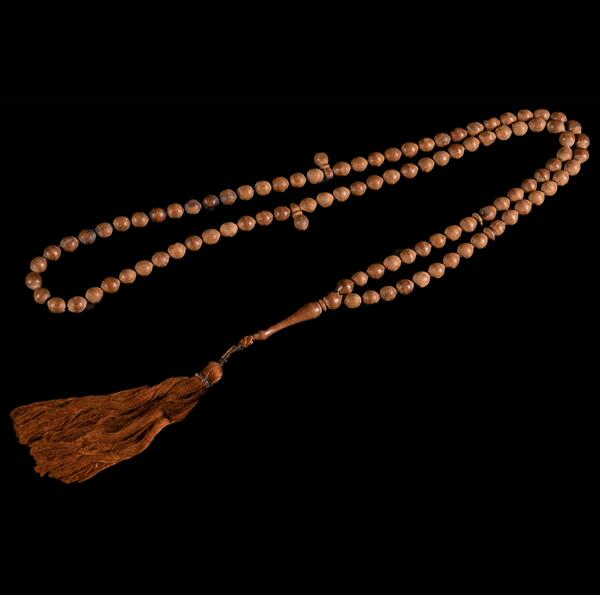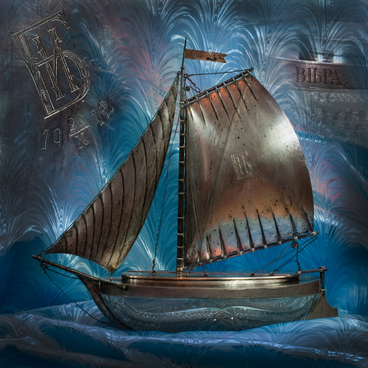The exhibit presents elegant cypress beads of Ivan Bunin. They consist of small balls, closely spaced to each other, and several flat discs. The beads are completed with a brush of brown threads.
Bunin brought these beads from a trip to the countries of the East, where he went with his future wife Vera Muromtseva in 1907.
Bunin and Muromtseva left Odessa and went through Constantinople to Egypt. From there they went to Jaffa, visited ancient Judea, Jerusalem. They made a trip to Hebron and Bethlehem, visited Jericho and the Dead Sea. Upon returning to Jerusalem, they went by sea through Jaffa to the north, to Lebanon and Syria, where they stayed in Beirut, Baalbek, Damascus, Gennisaret, Tiberias and Tabgha.
Vera Muromtseva preserved detailed memories of the trip of 1907 in her book ‘Conversations with Memory’. She paid special attention to the description of Jerusalem and Bethlehem.
‘We enter the courtyard paved with stone slabs, walk slowly, with some caution, and look eagerly at the heavy façade of the Temple. I feel with chagrin that it is impossible to go around the Temple – everything around is closely built up with some kind of high stone buildings.
All kinds of beads, crosses, holy pictures, pearl, cypress and others are laid out for sale on the marble porch, right on the stones. Our pilgrims leave the Temple – it is touching to see them here, far from their homeland, in an atmosphere alien to them, earnestly and reverently crossing themselves and bowing down to earth. Many of them have tears of joy in their eyes from the executed oath - to worship the Holy Sepulcher…
Calvary is the second floor of the church. Here we stand for quite a long time in gloomy silence, in a kind of eerie stupor… The Orthodox worship is taking place below, in the underground church. But we are still impressed by Calvary, and pomp and splendour of the divine worship leave us cold…
The road goes uphill; we drive past the Tomb of the Virgin Mary, past the Garden of Gethsemane – we decide to see around it on the way back, – then we go up the slope of the Mount of Olives. All around are the same glaucous-grey blocks, with nests of bright red poppies…
The Mount of Olives, as I have already mentioned, is crowned with an Orthodox church, very Russian, and it does not fit with the gloomy desolation of Judea at all; besides, as if on purpose, its domes are painted with a deep blue…
The densely crowded houses turned yellow on the eastern side of the hill: Bethlehem!
It is a small town surrounded by cultivated fields, with the church of the Nativity towering over it, in front of which we stopped. The church is double-stored, also looks as joyful. A star, the place where the manger located, – is on the floor in the lower church.
We stood for a long time on the white staircase of the church under a vaulted stone canopy. The sun rose high and joyfully flooded this happy of the happiest cities, and the spacious valley, hilly to the east, closed by the Moab mountains, the homeland of Ruth…’
Bunin brought these beads from a trip to the countries of the East, where he went with his future wife Vera Muromtseva in 1907.
Bunin and Muromtseva left Odessa and went through Constantinople to Egypt. From there they went to Jaffa, visited ancient Judea, Jerusalem. They made a trip to Hebron and Bethlehem, visited Jericho and the Dead Sea. Upon returning to Jerusalem, they went by sea through Jaffa to the north, to Lebanon and Syria, where they stayed in Beirut, Baalbek, Damascus, Gennisaret, Tiberias and Tabgha.
Vera Muromtseva preserved detailed memories of the trip of 1907 in her book ‘Conversations with Memory’. She paid special attention to the description of Jerusalem and Bethlehem.
‘We enter the courtyard paved with stone slabs, walk slowly, with some caution, and look eagerly at the heavy façade of the Temple. I feel with chagrin that it is impossible to go around the Temple – everything around is closely built up with some kind of high stone buildings.
All kinds of beads, crosses, holy pictures, pearl, cypress and others are laid out for sale on the marble porch, right on the stones. Our pilgrims leave the Temple – it is touching to see them here, far from their homeland, in an atmosphere alien to them, earnestly and reverently crossing themselves and bowing down to earth. Many of them have tears of joy in their eyes from the executed oath - to worship the Holy Sepulcher…
Calvary is the second floor of the church. Here we stand for quite a long time in gloomy silence, in a kind of eerie stupor… The Orthodox worship is taking place below, in the underground church. But we are still impressed by Calvary, and pomp and splendour of the divine worship leave us cold…
The road goes uphill; we drive past the Tomb of the Virgin Mary, past the Garden of Gethsemane – we decide to see around it on the way back, – then we go up the slope of the Mount of Olives. All around are the same glaucous-grey blocks, with nests of bright red poppies…
The Mount of Olives, as I have already mentioned, is crowned with an Orthodox church, very Russian, and it does not fit with the gloomy desolation of Judea at all; besides, as if on purpose, its domes are painted with a deep blue…
The densely crowded houses turned yellow on the eastern side of the hill: Bethlehem!
It is a small town surrounded by cultivated fields, with the church of the Nativity towering over it, in front of which we stopped. The church is double-stored, also looks as joyful. A star, the place where the manger located, – is on the floor in the lower church.
We stood for a long time on the white staircase of the church under a vaulted stone canopy. The sun rose high and joyfully flooded this happy of the happiest cities, and the spacious valley, hilly to the east, closed by the Moab mountains, the homeland of Ruth…’



